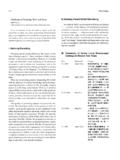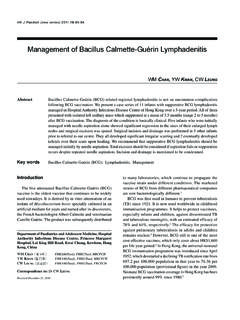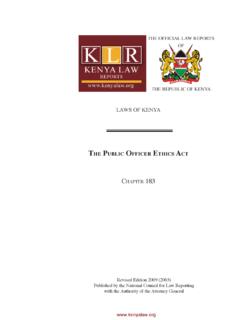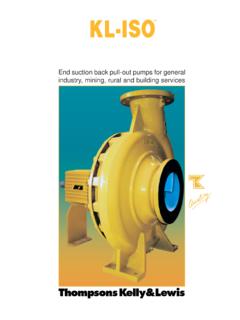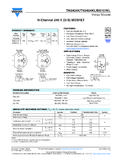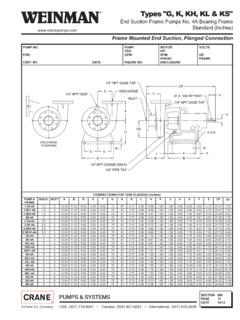Transcription of Use of Prostaglandin E2 in Neonatal Emergency Transport: …
1 HK J Paediatr (new series) 2002;7:223-226. Use of Prostaglandin E2 in Neonatal Emergency transport : a case Report KL SIU, WH LEE. Abstract A male newborn born in a private hospital with undiagnosed interrupted aortic arch presented with circulatory collapse on day 2 is reported. The Neonatal Emergency transport team (NET) used intravenous Prostaglandin E2 (PGE2) infusion at the referring hospital for suspected systemic ductus dependent congenital heart disease. He responded with improved circulation and was safely transported to Neonatal intensive care unit (NICU) of Queen Elizabeth Hospital.
2 Key words Interrupted aortic arch; Neonatal Emergency transport ; Newborn; Prostaglandin E. Introduction with intravenous Penicillin and Netromycin and received 60% supplementary oxygen by head box to keep SaO2. Prostaglandin E1 and E2 were shown to be effective in around 90 %. Blood tests at private hospital were as follows: symptomatic ductus dependent congenital heart CBC: Hgb: g/dl, WBC: x 109/L, Platelet: 261 x We report a case of undiagnosed interrupted aortic arch 109/L; ABG: pH: , PaCO2: KPa, PaO2: KPa, presented with circulatory collapse who was given PGE2 BE: , HCO3: 6 mmol/ L.
3 He was intubated for gasping infusion at referring hospital. He was stabilized and respiration at 38 hours of life with ventilator setting FiO2 : transferred to NICU by the NET. , Pressure 17/3 cm H2O, Rate 30 / min. He also received multiple doses of intravenous sodium bicarbonate and dopamine infusion of 5 ug/kg/min. case Report Our Neonatal Emergency transport Team (NET) was consulted and we arrived at the referring hospital 1 hour A Kg, full term male was born to a healthy mother later. He was pale and grey in colour, and his rectal by normal vaginal delivery in a private hospital.
4 The temperature was 36 C. He was in severe respiratory distress antenatal history was unremarkable and there was no risk and was on artificial ventilation. His circulation was poor of Neonatal sepsis. The family did not have history of with capillary refill time greater than 3 seconds. Peripheral congenital heart disease. He was well after birth but was pulses were not detectable and femoral pulses were feeble. noted to have severe tachypnea and marked pallor at 33 The apical heart rate was 180/min, and his apex was hours of life.
5 CXR was reported to be abnormal with displaced to 6th left intercostal space lateral to the left mid- features of chest infection and was suspicious of clavicular line. The precordium was active with strong right cardiomegaly (Figure 1). He was treated for chest infection ventricular impulses; the first heart sound was normal followed by single second heart sound, and gallop rhythm was heard. But there was no heart murmur. His oxygen Department of Paediatrics, Queen Elizabeth Hospital, 30 saturation by pulse oximetry and blood pressure by dinamap Gascoigne Road, Kowloon, Hong Kong, China were not recordable.
6 His umbilical arterial blood pressure KL SIU ( ) MBBS(HK), MRCP(UK), FHKAM(Paed) was 39/35 mmHg and these waveforms were flat in WH LEE ( ) MBBS(HK), FRCP(Edin, Glas), FHKAM(Paed) appearance. His liver was 3 cm below the right costal Correspondence to: Dr KL SIU margin. Received May 18, 2002 Base on the above clinical findings, continuous 224 Use of PGE2 in Neonatal Emergency transport Figure 1 CXR at private hospital. Congested Lung fields and cardiomegaly. intravenous PGE2 infusion was started at ug/kg/ min evaluation confirmed coagulopathy, renal and cardiac for suspected severe symptomatic systemic ductus impairments resulting from the preceding circulatory dependent congenital heart disease such as coarctation of collapse.
7 At 43 hours of life, he was transferred to Grantham aorta or interrupted aortic arch. He was also given Hospital for surgical intervention. intravenous furosemide, dopamine infusion 10 ug/kg/min, and intravenous sodium bicarbonate infusion to correct metabolic acidosis. By 15 minutes after starting PGE2 Discussion infusion, there was improvement in both arterial blood pressure from 39/35 mmHg to 51/39 mmHg and umbilical Prostaglandin E1 was shown to be effective in pulmonary arterial waveforms. An ejection systolic murmur was heard ductus dependent cyanotic congenital heart diseases, at the left upper sternal border though his femoral pulses systemic ductus dependent acyanotic congenital heart were still very weak.
8 He was transported to our NICU for diseases and some systemic pulmonary common mixing management. Parents were informed of his critically ill congenital heart PGE2 is as effective as PGE1, condition before departure. and there is oral preparation for , 5 Despite various On admission, the paediatric cardiologist echo- screening programmes for congenital heart disease before cardiographic evaluation confirmed the NET clinical and after birth, a large proportion of infants with congenital diagnosis of systemic ductus dependent congenital heart defects remain undetected and come to the attention of heart disease namely interrupted aortic arch.
9 9 mm the medical profession only after they develop perimembraneous ventricular septal defect, and mm These symptomatic infants can present in extremis and die patent ductus arteriosus with depressed left ventricular rapidly. Thus any delay in recognition and inefficient function (LVFS: 22%) while on 10 ug/kg/min dopamine stabilization of these symptomatic neonates increases infusion. His femoral pulses were palpable three hours after morbidity and starting PGE2 infusion and the umbilical arterial blood Neonatal Emergency transport team (NET) is a well- pressure was 70/41 mmHg.
10 However, biochemical trained specialized team functioning as an ambulatory Siu and Lee 225. Neonatal intensive care unit. The team should be able to but his femoral pulses were only well felt and blood pressure handle and stabilize ill neonates of various medical, surgical well improved by 3 hours. It has been suggested that problems unaided in an unfamiliar environment, and favourable determinants of responsiveness are initially low transport ill neonates safely to the receiving NICU. In most arterial PaO 2 and an age of less than 96 hours, while situations, the exact diagnosis of congenital heart defects unfavourable determinants of responsiveness are an will be rarely available to the NET during the initial irreversibly closed ductus, severe acidemia and evaluation at the referring hospital.
